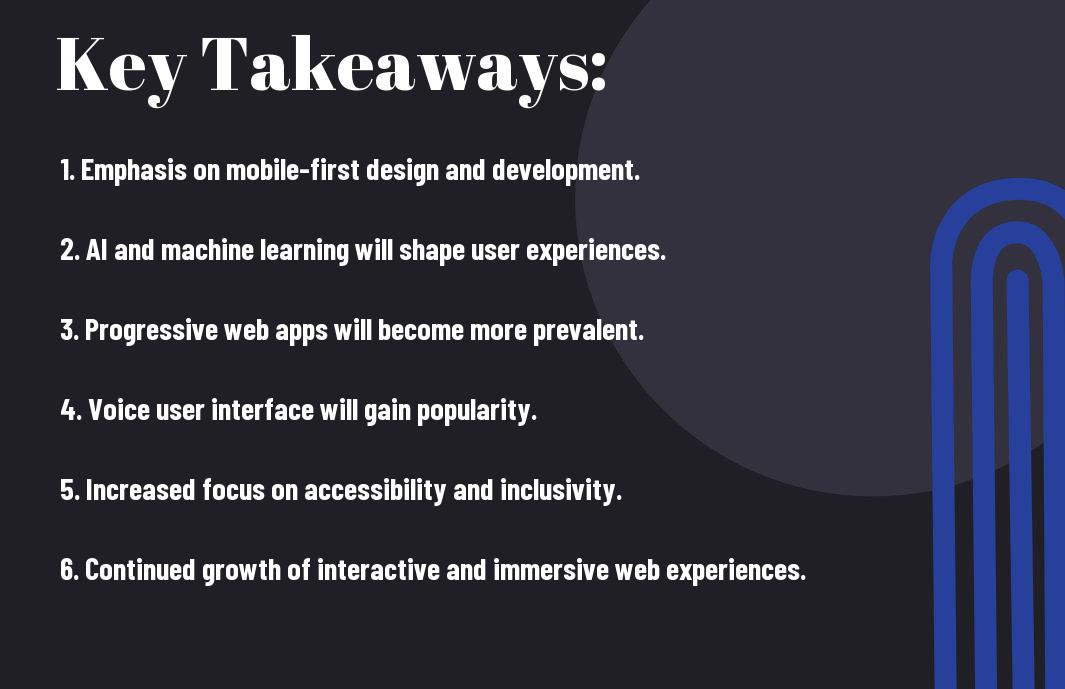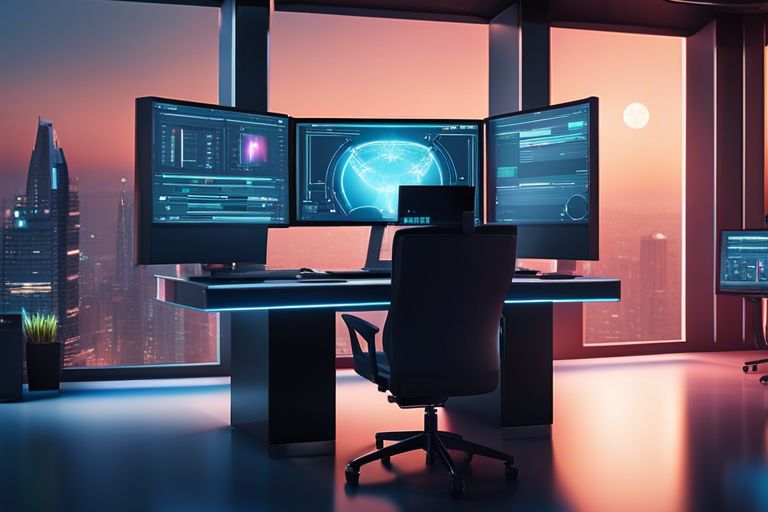Embarking on the journey of understanding the future of web design and development can be both exciting and daunting, especially with the constantly evolving trends and technologies. However, as a web designer or developer, it is crucial for you to stay ahead of the curve and anticipate the upcoming changes to create impactful and successful digital experiences. In this informative blog post, we will explore the most important and dangerous trends that will shape the future of web design and development, as well as the positive opportunities and possibilities that lie ahead. By staying informed and embracing the changes, you will be better equipped to adapt and thrive in the ever-changing landscape of web design and development.
Key Takeaways:
- Responsive design is crucial for the future of web design and development as more users access websites from mobile devices.
- Integrated user experience and interface design will be essential to create seamless and intuitive web experiences.
- Advanced technologies such as AI, machine learning, and AR/VR will play a significant role in shaping the future of web design and development.

The Impact of Artificial Intelligence and Machine Learning
Obviously, the future of web design and development will be heavily influenced by the rapid advancement of artificial intelligence (AI) and machine learning. These technologies are already revolutionizing the industry, providing new tools and capabilities that were once unimaginable. If you want to stay relevant in the field, it’s crucial to understand how AI and machine learning are shaping the future of web design and development. To learn more, you can check out this insightful article on The Future of Web Design: Navigating Trends and Innovations.
AI-Driven Design Tools
AI-driven design tools are becoming increasingly prevalent in the industry, allowing you to automate repetitive tasks and generate personalized, data-driven designs. With these tools, you can streamline your workflow and focus on more creative, high-level tasks, while leaving the repetitive work to the AI. This not only saves you time but also ensures a consistent, high-quality output for your web design projects.
Machine Learning for Personalization
Machine learning is enabling unprecedented levels of personalization on the web. By analyzing user data and behavior, machine learning algorithms can deliver personalized content and experiences to your audience, increasing engagement and conversion rates. Implementing machine learning for personalization on your websites can significantly enhance the user experience and drive business success.

The Role of Frameworks and Libraries
Your understanding of the role of frameworks and libraries in web design and development is crucial to staying ahead in the field. These tools are essential for streamlining your development process, increasing efficiency, and ensuring optimal performance. To stay updated on the latest trends and predictions for web design in 2023, you can also check out The Future of Web Design: Predictions and Trends for 2023.
The Rise of JavaScript Frameworks
In recent years, JavaScript frameworks such as React, Angular, and Vue have gained significant popularity in the web development community. These frameworks offer a range of benefits, including improved flexibility, better performance, and enhanced user experience. By leveraging the power of these frameworks, you can create dynamic and responsive web applications with ease. However, it is important to stay updated on the latest updates and best practices to ensure that you are making the most of these powerful tools.
The Shift Towards Component-Based Architecture
Another important trend in web design and development is the shift towards component-based architecture. By breaking down the user interface into reusable components, you can create more scalable and maintainable code. This approach also facilitates collaboration and allows for greater flexibility in making design updates and improvements. Embracing component-based architecture can help you create more robust and adaptable web applications, keeping your codebase organized and manageable.
Trends in User Interface and User Experience
Unlike the static and traditional user interfaces of the past, the future of web design and development is embracing dynamic and interactive user interfaces to enhance user experience. As technology continues to evolve, it’s important to keep up with the latest trends in user interface and user experience to stay ahead in the competitive digital landscape. Let’s explore some of the emerging trends in user interface and user experience that are shaping the future of web design and development.
The Emergence of Voice and Gesture-Based Interactions
With the rise of smart devices and virtual assistants, voice and gesture-based interactions are becoming increasingly popular. This trend is revolutionizing the way users interact with websites and applications, allowing for hands-free and intuitive navigation. By integrating voice and gesture-based interactions into your web design and development, you can provide a more seamless and natural user experience for your audience. This trend also opens up new possibilities for accessibility, as it allows individuals with physical disabilities to navigate and interact with digital content in a more inclusive manner.
Accessibility and Inclusive Design Principles
Accessibility and inclusive design principles are no longer just options, but essential components of modern web design and development. It’s crucial to ensure that your website or application is accessible to all users, regardless of their physical or cognitive abilities. By incorporating accessible design principles into your projects, you can create a more inclusive and welcoming user experience for everyone. This includes implementing features such as alt text for images, captioning for videos, and keyboard navigation for those who rely on assistive technologies. Embracing accessibility not only expands your audience reach but also demonstrates your commitment to creating a more equitable online environment.
The Advancement of Web Performance and Optimization
Despite the ever-increasing complexity of web design and development, one thing remains a top priority: web performance and optimization. As an integral part of the user experience, the speed and efficiency of your website can make or break its success. In today’s fast-paced digital landscape, ensuring your website loads quickly and operates seamlessly across devices is crucial.
Importance of Speed and Efficiency
When it comes to web design and development, the importance of speed and efficiency cannot be overstated. In a world where attention spans are dwindling and competition is fierce, every second counts. Research shows that roughly 40% of people will abandon a website that takes more than 3 seconds to load. This means that if your website isn’t optimized for speed, you could be losing nearly half of your potential audience before they even have a chance to see what you have to offer. In addition to keeping visitors on your site, a fast-loading website also improves your search engine rankings and overall user satisfaction.
Emerging Technologies for Enhanced Performance
Thankfully, there are a variety of emerging technologies and techniques that can help enhance the performance of your website. From image optimization and lazy loading to content delivery networks and server-side rendering, there are numerous strategies you can implement to improve your website’s speed and efficiency. Additionally, the rise of Progressive Web Apps (PWAs) and Accelerated Mobile Pages (AMP) has opened up new possibilities for creating fast, engaging web experiences. By embracing these technologies, you can ensure that your website not only meets but exceeds user expectations for performance.
The Future of Web Design and Development
Summing up, the future of web design and development is filled with exciting possibilities and advancements. As technology continues to evolve, so will the way we design and develop websites. It’s important to stay up-to-date with the latest trends and technologies to ensure that your websites are modern, user-friendly, and visually appealing. By utilizing responsive design, optimizing for mobile devices, and staying on top of emerging tech such as AI and AR, you can ensure that your web design and development work remains relevant and impactful. Embracing new tools and techniques will be crucial as we continue to push the boundaries of what is possible in the digital world.
FAQ
Q: What is the future of web design and development?
A: The future of web design and development lies in the continued evolution of user experience, responsive design, and the integration of artificial intelligence and machine learning.
Q: How will user experience evolve in web design and development?
A: User experience will continue to prioritize seamless and intuitive interactions, personalized content, and accessibility for all users, including those with disabilities.
Q: What role will responsive design play in the future of web design and development?
A: Responsive design will be essential as users access the web on a wide range of devices, from smartphones and tablets to desktop computers and smart TVs.
Q: How will artificial intelligence and machine learning impact web design and development?
A: AI and machine learning will enable more personalized and predictive experiences, as well as automation of repetitive tasks such as content generation and website maintenance.
Q: What are some emerging technologies that will shape the future of web design and development?
A: Emerging technologies such as virtual and augmented reality, voice interfaces, and the Internet of Things will offer new opportunities for creative and immersive web experiences.
CATEGORY:Website Design

